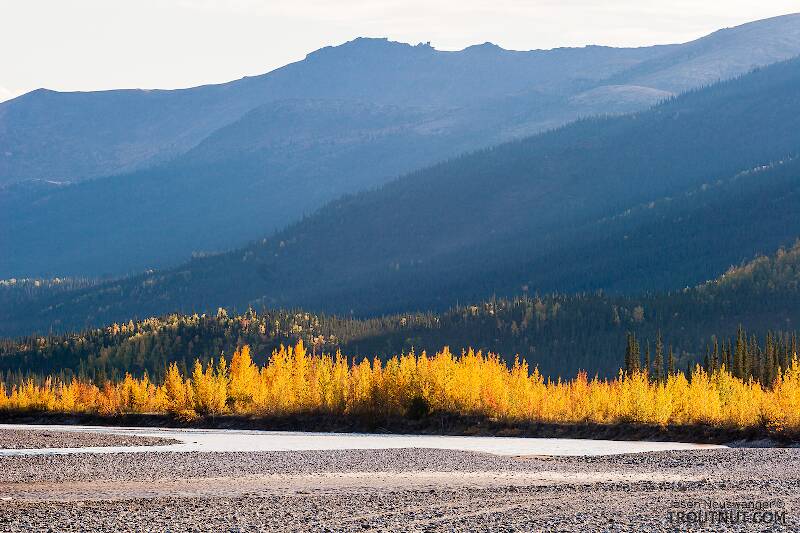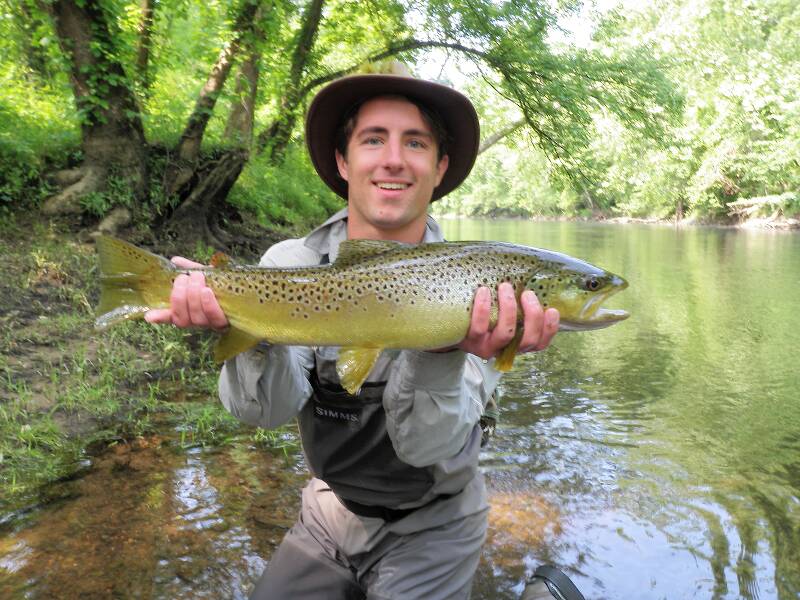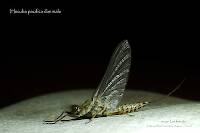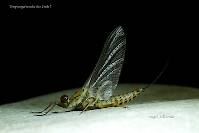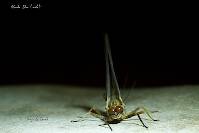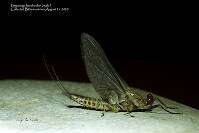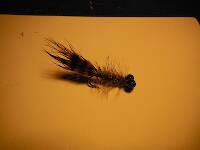
Salmonflies
Pteronarcys californica
The giant Salmonflies of the Western mountains are legendary for their proclivity to elicit consistent dry-fly action and ferocious strikes.
Featured on the forum

This specimen resembled several others of around the same size and perhaps the same species, which were pretty common in my February sample from the upper Yakima. Unfortunately, I misplaced the specimen before I could get it under a microscope for a definitive ID.

Troutnut is a project started in 2003 by salmonid ecologist Jason "Troutnut" Neuswanger to help anglers and
fly tyers unabashedly embrace the entomological side of the sport. Learn more about Troutnut or
support the project for an enhanced experience here.
Jesse on Aug 13, 2012August 13th, 2012, 10:04 am EDT
Hello MY FRIENDSSSS!!!!!!!!!!! I'm not back for good yet but have limited access to a computer via a small town in Canada. What hatches are going to be most prominent in the northern-eastern U.S. during the fall??
Jesse
Jesse
Most of us fish our whole lives..not knowing its not the fish that we are after.
http://www.filingoflyfishing.com
http://www.filingoflyfishing.com
PaulRoberts on Aug 13, 2012August 13th, 2012, 10:28 am EDT
I sure hope you are planning a long write-up with images and circles and arrows n stuff. A las, I'm still sitting here at my desk.
GONZO on Aug 13, 2012August 13th, 2012, 3:46 pm EDT
Hi Jesse,
Because I'm jealous of your freedom to gallivant after trout for such long periods of time, I'm tempted to leave you to your own devices.... :)
Instead, here are a few thoughts in response to your question:
Baetids--I won't call them BWOs, but these (variously colored) little buggers are among the most significant and reliable mayflies in the late season. Although they have the reputation of being "bad weather" bugs, that's not always the case, especially in the late fall.
Slate Drakes (Isonychia spp.)--A second "batch" can be significant on many streams in September, though they are usually smaller (#12-14) than the earlier ones. I have a special fondness for these fast-swimming critters, so I wouldn't be without an Iso nymph imitation on any stream with good populations.
Tricos--They can linger into early November in some places, though their number (and consequently, their significance) dwindles quite a bit as September rolls into October.
Little Yellow Quills (Leucrocuta spp.)--These little (#16-18) mayflies look like smallish Sulphurs from a distance, but they have two tails and small dark flecks on the forward half of the wings. They usually emerge in riffles and can emerge underwater, so small wet flies often work when the fish aren't taking them on the surface. They are a fairly common and widespread mid-late season hatch, and can linger into October. IMO, they are very underrated.
Autumn Mottled Sedges (Neophylax spp.)--These medium-sized (#12-16) brownish mottled caddisflies are sometimes seen in good numbers in the fall. I usually encounter them on smallish streams, but I don't know if that is typical. The Eastern Box Wing Sedge (Ironoquia spp.) is a rusty brown-colored caddisfly of about the same size or slightly larger that might also be significant in a few places.
Great Brown Autumn Sedges (Pycnopsyche spp., sometimes called October Caddis or Pumpkin Caddis)--These large (#8-10) caddisflies have brownish orange or pumpkin-colored wings, usually with a few dark blotches toward the rear. Most often seen around dusk into dark, I've had the best results with large rusty or orangish imitations of the "pupa." A large Orange Stimulator can sometimes get a good response on the surface in the fall (whether or not that response is related to these caddisflies).
Hoppers, beetles, and ants are standard fare for prospecting on the surface until you get a few hard freezes. As you get later into the late season, prospecting with things like streamers, stonefly nymphs, or small-to-tiny nymphs (that imitate the early stages of some of next year's crop) can be productive. Of course, through the end of October into November and December, you might want to consider imitating what is often the most productive late-season "hatch" on many streams...eggs.
Because I'm jealous of your freedom to gallivant after trout for such long periods of time, I'm tempted to leave you to your own devices.... :)
Instead, here are a few thoughts in response to your question:
Baetids--I won't call them BWOs, but these (variously colored) little buggers are among the most significant and reliable mayflies in the late season. Although they have the reputation of being "bad weather" bugs, that's not always the case, especially in the late fall.
Slate Drakes (Isonychia spp.)--A second "batch" can be significant on many streams in September, though they are usually smaller (#12-14) than the earlier ones. I have a special fondness for these fast-swimming critters, so I wouldn't be without an Iso nymph imitation on any stream with good populations.
Tricos--They can linger into early November in some places, though their number (and consequently, their significance) dwindles quite a bit as September rolls into October.
Little Yellow Quills (Leucrocuta spp.)--These little (#16-18) mayflies look like smallish Sulphurs from a distance, but they have two tails and small dark flecks on the forward half of the wings. They usually emerge in riffles and can emerge underwater, so small wet flies often work when the fish aren't taking them on the surface. They are a fairly common and widespread mid-late season hatch, and can linger into October. IMO, they are very underrated.
Autumn Mottled Sedges (Neophylax spp.)--These medium-sized (#12-16) brownish mottled caddisflies are sometimes seen in good numbers in the fall. I usually encounter them on smallish streams, but I don't know if that is typical. The Eastern Box Wing Sedge (Ironoquia spp.) is a rusty brown-colored caddisfly of about the same size or slightly larger that might also be significant in a few places.
Great Brown Autumn Sedges (Pycnopsyche spp., sometimes called October Caddis or Pumpkin Caddis)--These large (#8-10) caddisflies have brownish orange or pumpkin-colored wings, usually with a few dark blotches toward the rear. Most often seen around dusk into dark, I've had the best results with large rusty or orangish imitations of the "pupa." A large Orange Stimulator can sometimes get a good response on the surface in the fall (whether or not that response is related to these caddisflies).
Hoppers, beetles, and ants are standard fare for prospecting on the surface until you get a few hard freezes. As you get later into the late season, prospecting with things like streamers, stonefly nymphs, or small-to-tiny nymphs (that imitate the early stages of some of next year's crop) can be productive. Of course, through the end of October into November and December, you might want to consider imitating what is often the most productive late-season "hatch" on many streams...eggs.
Oldredbarn on Aug 13, 2012August 13th, 2012, 5:09 pm EDT
Because I'm jealous of your freedom to gallivant after trout for such long periods of time, I'm tempted to leave you to your own devices.... :)
You're a push over G. :) Though it sounds like you are ready for fall. Nice synopsis there.
Spence
"Even when my best efforts fail it's a satisfying challenge, and that, after all, is the essence of fly fishing." -Chauncy Lively
"Envy not the man who lives beside the river, but the man the river flows through." Joseph T Heywood
"Envy not the man who lives beside the river, but the man the river flows through." Joseph T Heywood
Jesse on Aug 17, 2012August 17th, 2012, 12:42 pm EDT
Haha thanks Gonz i appreciate that!
Most of us fish our whole lives..not knowing its not the fish that we are after.
http://www.filingoflyfishing.com
http://www.filingoflyfishing.com
Quick Reply
Related Discussions
Topic
Replies
Last Reply
0
Sep 26, 2006
by Troutnut
by Troutnut
Re: You Western anglers - any experience with the Giant Orange Sedges?
In the Caddisfly Genus Dicosmoecus by Troutnut
In the Caddisfly Genus Dicosmoecus by Troutnut
7
Jan 7, 2009
by Dgracia
by Dgracia
6
Sep 24, 2013
by Jmd123
by Jmd123

